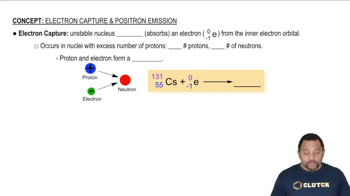Here are the essential concepts you must grasp in order to answer the question correctly.
Nuclear Fission
Nuclear fission is a process in which the nucleus of an atom splits into two or more smaller nuclei, along with the release of energy and neutrons. This reaction can occur spontaneously or can be induced by the absorption of a neutron. In the context of nuclear reactors, fission is primarily used to generate energy, with isotopes like uranium-235 and plutonium-239 being common fuels.
Recommended video:
Band of Stability: Nuclear Fission
Isotopes and Neutron Capture
Isotopes are variants of a chemical element that have the same number of protons but different numbers of neutrons. In the case of uranium-238, it is a stable isotope that does not undergo fission readily. However, when it captures a neutron, it can transform into a different isotope, which may be fissile, such as plutonium-239, through a series of nuclear reactions.
Recommended video:
Balanced Nuclear Equations
A balanced nuclear equation represents a nuclear reaction, ensuring that the total number of nucleons (protons and neutrons) and the charge are conserved. In these equations, the reactants and products are written with their respective atomic numbers and mass numbers. Balancing these equations is crucial for accurately depicting the transformation of elements during nuclear reactions, such as the conversion of uranium-238 to plutonium-239.
Recommended video:
Balancing Chemical Equations




